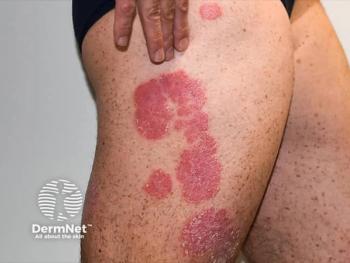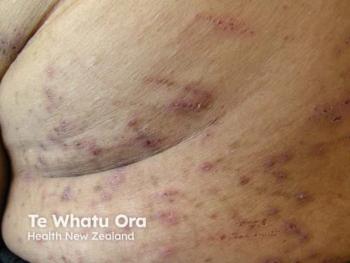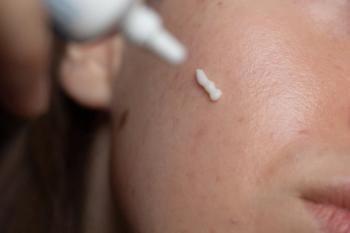
GLP-1 Therapy Offers Dual Benefits for Skin and Heart
Key Takeaways
- Chronic inflammatory skin diseases are associated with increased cardiovascular risk due to systemic inflammation, evidenced by elevated CRP and TNF-α levels.
- GLP-1RAs, used in type 2 diabetes management, show potential in reducing cardiovascular events in patients with inflammatory skin diseases.
GLP-1 receptor agonists show promise in reducing cardiovascular risks for patients with chronic inflammatory skin diseases like psoriasis and atopic dermatitis.
Chronic inflammatory skin diseases such as hidradenitis suppurativa (HS), psoriasis (PsO), and atopic dermatitis (AD) are increasingly recognized not only for their dermatologic burden but also for their systemic effects, including elevated cardiovascular risk.1 This association is primarily attributed to persistent systemic inflammation, as evidenced by elevated markers such as C-reactive protein (CRP) and tumor necrosis factor-alpha (TNF-α), which contribute to endothelial dysfunction, atherosclerosis, and other cardiovascular pathologies.2
In light of these findings, attention has turned to the potential cardiovascular benefits of therapies that modulate systemic inflammation. Among these, glucagon-like peptide-1 receptor agonists (GLP-1RAs), commonly used in the management of type 2 diabetes and obesity, have shown promise in reducing long-term cardiovascular risk. However, until now, little was known about their cardioprotective effects in patients with dermatologic conditions characterized by chronic inflammation.3
A recent population-based cohort study presented by researchers from the David Geffen School of Medicine at UCLA at the Society for Investigative Dermatology Annual Meeting 2025 addresses this important knowledge gap. The study, titled "The Impact of GLP-1 Receptor Agonists on Major Adverse Cardiovascular Events Among Hidradenitis Suppurativa, Psoriasis, and Atopic Dermatitis Patients: A Population-Based Cohort Study ", examined whether GLP-1RAs are associated with reduced major adverse cardiovascular events (MACE) in patients with HS, PsO, or AD.
Using the TriNetX Research Network database spanning 2005 to 2024, the researchers identified adult patients (≥12 years old) with diagnoses of HS, PsO, or AD who were prescribed GLP-1RAs. These patients were then matched using 1:1 propensity score matching with non-GLP-1RA users based on demographics, common cardiovascular risk factors, and comorbidities such as hypertension, obesity, and type 2 diabetes mellitus. Patients with a prior history of MACE were excluded from the analysis to ensure a more accurate assessment of GLP-1RA effects.
The primary outcome measured was the incidence of MACE over 1-, 5-, and 10-year follow-up periods. The analysis revealed a consistent trend: GLP-1RA users had significantly reduced odds of experiencing MACE compared to matched controls who had not used these medications. The reduction was observed across all three dermatologic conditions studied.
The results are visually summarized in the poster using odds ratios (ORs) with 95% confidence intervals, and show statistically significant reductions in cardiovascular outcomes, including myocardial infarction, stroke, and cardiovascular death. For example, in patients with psoriasis, those treated with GLP-1RAs demonstrated lower odds of cardiovascular events than those who had not received GLP-1RAs.
The findings support a growing body of evidence indicating that GLP-1RAs offer benefits that extend beyond glycemic control. Specifically, they suggest a potential role for GLP-1RAs in managing patients with chronic inflammatory skin diseases who are at increased cardiovascular risk. The anti-inflammatory properties of GLP-1RAs may underpin this benefit, making them a compelling therapeutic consideration in this patient population.
Overall, the study provides strong real-world evidence for the cardiovascular protective effects of GLP-1RAs in patients with HS, PsO, and AD. These findings underscore the importance of interdisciplinary approaches that consider the systemic implications of dermatologic diseases. Future prospective studies and longitudinal analyses will be crucial to elucidate the mechanisms at play and to determine the long-term efficacy and safety of GLP-1RAs in this unique clinical setting.
As the medical community continues to explore the intersection between dermatology and cardiometabolic health, GLP-1RAs may representa paradigm shift in the comprehensive care of patients with inflammatory skin diseases.
References
- Becherel PA, Reguiai Z, Fougerousse AC, et al. Compared burden of psoriasis, atopic dermatitis, hidradenitis suppurativa, and chronic urticaria: Baseline characteristics of the patients included in the OMCCI cohort - A French, prospective multicenter study of chronic inflammatory dermatoses. Dermatology. 2024;240(5-6):702-712. doi:10.1159/000540250
- Medina-Leyte DJ, Zepeda-García O, Domínguez-Pérez M, González-Garrido A, Villarreal-Molina T, Jacobo-Albavera L. Endothelial dysfunction, inflammation and coronary artery disease: Potential biomarkers and promising therapeutical approaches. Int J Mol Sci. 2021 Apr 8;22(8):3850. doi: 10.3390/ijms22083850. PMID: 33917744; PMCID: PMC8068178.
- Ma E, Roberts A, Jeong C, et al. The impact of GLP-1 receptor agonists on major adverse cardiovascular events among hidradenitis suppurativa, psoriasis, and atopic dermatitis patients: A population-based cohort study. Poster presented at: Society for Investigative Dermatology Annual Meeting; May 7-10; San Diego, California.
Newsletter
Like what you’re reading? Subscribe to Dermatology Times for weekly updates on therapies, innovations, and real-world practice tips.


















